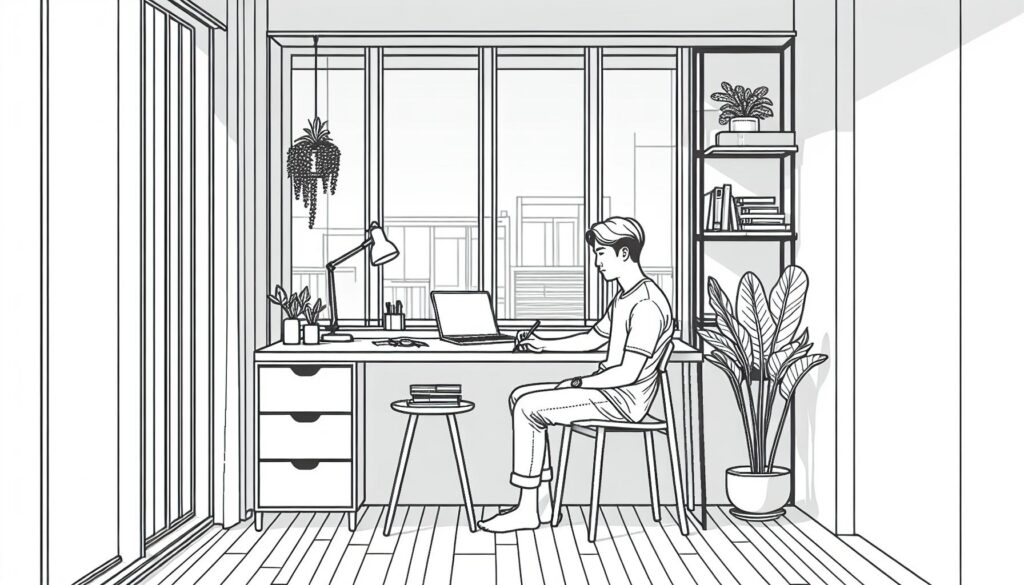When it comes to boosting productivity and focus while working from home, creating a minimalist workspace is key. As someone who has navigated the challenges of remote work, I understand the importance of a clutter-free environment. In this article, I’ll share practical tips on how to design a minimalist workspace that inspires creativity and efficiency.
With the rise of telecommuting, it’s essential to carve out a dedicated space that promotes a clear mind and sharp thinking. In my experience, simplifying your home office setup can lead to a more organized and harmonious work routine. Follow along as I delve into the art of minimalism and its transformative effects on your productivity levels.
Join me on this journey to streamline your work environment and unlock your full potential. Let’s explore the power of minimalism in cultivating a workspace that nurtures innovation and success.
Assessing Your Current Workspace
When assessing your current workspace, start by evaluating the setup you currently have. Look around and take note of clutter that might be affecting your focus and productivity. Ensure that your desk, chair, and lighting are conducive to a productive work environment.
Consider the following points:
- Is your desk cluttered with unnecessary items?
- Do you have adequate lighting to prevent eye strain?
- Is your chair comfortable and ergonomically designed for long hours of work?
- Are there distractions in your workspace that hinder your concentration?
Take stock of what is working well and what needs improvement in your current setup. Identify areas that you can declutter and streamline to create a more efficient and inspiring workspace.
Remember, a well-thought-out workspace is essential for boosting your productivity and fostering creativity.
Decluttering and Organization Strategies
When it comes to creating a minimalist workspace at home, decluttering is key. Start by removing unnecessary items from your desk and surrounding area. Keep only the essentials that you use daily to avoid distractions.
To maximize space, consider using storage solutions like shelves, drawers, or bins to keep your workspace organized. Invest in desk organizers for pens, papers, and other supplies to maintain a clutter-free environment.
Implement a filing system for important documents and papers to prevent them from piling up on your desk. Make use of digital tools for note-taking and file storage to reduce the need for physical paper clutter.
Regularly review and purge items that you no longer need. Simplifying your workspace not only improves productivity but also creates a more peaceful and focused environment for work.
Remember, a clean and organized workspace can have a significant impact on your productivity and overall well-being, so take the time to declutter and streamline your home office setup.
Choosing Essential Furniture and Decor
When it comes to creating a minimalist workspace at home, choosing essential furniture and decor is key. Here are some tips to help you select the right pieces:
- Invest in a quality desk and chair that provide ergonomic support.
- Opt for neutral colors and simple designs to maintain a clean and uncluttered look.
- Consider multifunctional furniture that serves more than one purpose, such as a desk with built-in storage.
- Integrate indoor plants to add a touch of greenery and promote a sense of calmness.
- Use natural light to brighten up your workspace and reduce the need for excess lighting.
- Avoid excessive decorations that can cause distractions and clutter your workspace.
By carefully selecting essential furniture and decor items, you can create a minimalist workspace that is both functional and aesthetically pleasing.
Maximizing Natural Light and Greenery
When setting up a minimalist workspace at home, natural light is my go-to element for creating a bright and airy atmosphere. I position my desk near a window to make the most of this free and energizing light source throughout the day.
Greenery plays a pivotal role in bringing a touch of nature indoors. I adorn my workspace with indoor plants to not only add a pop of color but also to purify the air, reduce stress, and boost my mood.
Optimizing the placement of plants by strategic positioning around the workspace enhances the aesthetic appeal while promoting a sense of tranquility. Additionally, incorporating a variety of plant sizes and shapes adds visual interest and personality to the space.
A well-lit and green-filled workspace is my secret to fostering a calm and productive environment that keeps me motivated and inspired throughout the day.
| Natural Light Statistics | Data |
|---|---|
| Percentage of workers wanting more natural light in the workplace | 47% |
| Productivity increase in well-lit workspaces | 15% |
Establishing a Minimalist Digital Space
When it comes to creating a minimalist workspace at home, decluttering my digital environment is just as crucial as organizing my physical space. Here are a few key steps I take to establish a streamlined and efficient digital workspace:
- Organize Folders: I categorize my files into folders with clear labels to ensure ease of access and a clutter-free desktop.
- Limit Desktop Icons: I keep only essential icons on my desktop to avoid distractions and maintain a clean aesthetic.
- Digital Calendar: Utilizing a digital calendar helps me stay organized and on top of my tasks and appointments without the need for physical reminders.
- Cloud Storage Solutions: Storing files in the cloud not only frees up space on my devices but also allows me to access them from anywhere.
- Digital Minimalism Tools: I incorporate tools like RescueTime to track my online activity and ensure I’m focusing on tasks efficiently.
By implementing these strategies, I create a minimalist digital space that complements my physical workspace, promoting a focused and productive work environment.
Key Takeaways
- Assess your current workspace for clutter and distractions that may hinder focus and productivity.
- Declutter your workspace by removing unnecessary items and organizing essentials with storage solutions.
- Choose essential furniture and decor with neutral colors and multifunctional features for a minimalist look.
- Maximize natural light and incorporate greenery to create a bright, airy, and calming workspace.
- Establish a minimalist digital space by organizing folders, limiting desktop icons, utilizing digital calendars, and using cloud storage solutions.
- Regularly review and purge items, both physical and digital, to maintain a streamlined and efficient workspace for enhanced productivity and well-being.
Conclusion
Creating a minimalist workspace at home is a powerful way to enhance productivity and well-being. By maximizing natural light and adding greenery, you can transform your workspace into a tranquil and inspiring environment. Strategic placement of your desk near a window and incorporating indoor plants can significantly boost your mood and focus. Studies show that workers thrive in well-lit spaces, with productivity increasing by 15%. Embracing a minimalist digital space by organizing folders, limiting desktop icons, and utilizing digital tools can further elevate your efficiency. By prioritizing simplicity and nature in your workspace, you can cultivate a calm and productive atmosphere that fuels your motivation and creativity.



